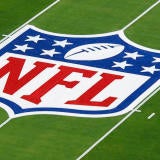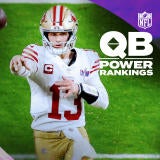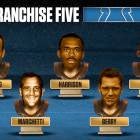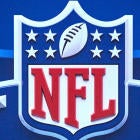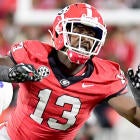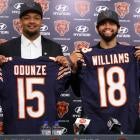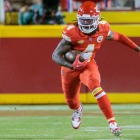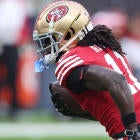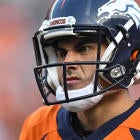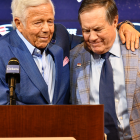
On March 29, 1984, a dozen Mayflower moving vans stuffed with Colts equipment left Baltimore in the middle of the night and headed 600 miles west to Indianapolis. It wasn't the first sports franchise relocation or the last, but it was a particularly memorable one, and it created a mountainous dividing line in the history of one of the NFL's iconic teams.
Compare the Colts on either side of that 1984 night and what's striking is how the eras mirror each other. Baltimore had the Colts for 31 seasons, Indianapolis for 36 and counting. In each city, one Super Bowl win and one Super Bowl loss. In Baltimore, a 222-194-7 record (.533 win percentage). In Indy, 301-274 (.523).
And the symmetry extends to who's worn the Colts uniform. Both Baltimore and Indianapolis were armed with an all-time great receiver (Raymond Berry/Marvin Harrison), a terrifying pass rusher (Gino Marchetti/Dwight Freeney) and a Hall of Fame pass-catching running back (Lenny Moore/Edgerrin James).
Nowhere, though, are the similarities more striking than at quarterback. The Colts have had not one, but two who are routinely ranked among the 10 greatest players in NFL history: Johnny Unitas and Peyton Manning.
Manning and Unitas are the greatest Colts ever. There's really no debate. But here's the thing: only one of them can make the list below. Our Franchise Five series identifies the five most important figures in a team's history with the following parameters: the five must be made up of one coach, one quarterback, and three players who aren't quarterbacks.
There are some tough decisions ahead (a fist bump goes to Baltimore native and CBS Sports NFL Insider Jason La Canfora for giving the Franchise Five — chosen by this Indiana native and Colts fan — his stamp of approval), so buckle up and let's dive in.
QB Peyton Manning
Colts career: 1998-2010
Manning's the pick, which means Johnny Unitas — 3 NFL championships including a Super Bowl title, 10 Pro Bowls, 7-time All-Pro, 3 league MVPs — is not part of our Franchise Five. Approximately nine players in NFL history were better than Unitas, and one of them happened to play for the same team and at the same position.
(It's worth taking a moment here to point out just how blessed the Colts have been at QB. There is no team/position combination more likely to produce a league MVP. There have been nine Colts MVPs — the most of any franchise — since the award began in 1957, and all were signal-callers: Manning was MVP four times as a Colt, Unitas three, Earl Morrall and Bert Jones once each. That's four more than the second most common team/position MVP combo: Packers QB and 49ers QB, with five apiece).
There isn't much to defend, of course, in putting Manning on a list of all-time greats. He either holds or has held every major NFL passing record. His list of accolades includes 4 MVPs with the Colts (and one more with Denver), 12 total Pro Bowls, 7 times an All-Pro, and a Super Bowl title with the Colts (plus one more with the Broncos). He ranks third all-time in career passing yards and TDs. Nobody prepared as he did. Nobody knew more about what the defense was doing. Even considering only the 13 seasons he played for the Colts, there's no comparison between Manning's stats and Unitas' 17 seasons in a Colts uniform.
| Starts | Record | Comp | Attempts | Comp% | Yards | TDs | INTs | Yds/att | |
|---|---|---|---|---|---|---|---|---|---|
Manning | 208 (266) | 141-67 (186-79) | 4,682 (6,125) | 7,210 (9,380) | 64.9 (65.3) | 54,828 (71,940) | 399 (539) | 198 (251) | 7.6 (7.7) |
Unitas | 181 (206) | 117-60-4 (118-63-4) | 2,796 (2,830) | 5,110 (5,186) | 54.7 (54.6) | 39,768 (40,239) | 287 (290) | 246 (253) | 7.8 (7.8) |
* Stats with Colts are listed first, career stats in parentheses (Manning played four seasons with the Broncos, Unitas one with the Chargers)
But stats aren't everything. Unitas played in a different era. Teams didn't pass as often. Compared to his peers in the 1950s and '60s, Unitas was as dominant as Manning.
Manning gets the nod here because, as the accolades and statistics above suggest, he might be the greatest player … ever. He reached the Super Bowl four times with four different coaches and two different teams (a relevant stat in the G.O.A.T. debate if a certain Patriots QB, who has spent his entire career with one legendary coach, fizzles without Bill Belichick). And as for the one knock against Manning, that he can't win when it counts most — only two quarterbacks have won more playoff games (14) in NFL history.
Coach Tony Dungy
Colts career: 2002-08
How good was Dungy? If you consider only his Colts seasons, when he went 85-27, Dungy would be tied for the second-highest win percentage in NFL history at .759 (Guy Chamberlain, who coached from 1922-27, is first).
Dungy's Colts teams never missed the playoffs in his seven seasons. Other than his first year in Indianapolis, when the Colts went 10-6, Dungy's Colts never finished worse than 12-4. A soft-spoken leader who had previously turned the lowly Bucs into a perennial playoff team, Dungy — known for his defensive success and the Tampa 2 — abandoned his conservative offensive philosophy to fit what the Colts already had, while improving the defense. And it worked perfectly, highlighted by the Colts' second Super Bowl win and first since moving to Indianapolis, as Dungy became the first Black coach to win a Super Bowl.
But as great as Dungy was — and keeping with the theme here — there were coaches on the other side of the 1984 divide who were nearly as good in Baltimore. Don Shula, before winning championships with the Dolphins, went 71-23-4 (.755) as Colts coach, but lost Super Bowl III. Don McCafferty won Super Bowl V the year after Shula left for Miami, but coached only two-plus seasons in Baltimore, going 22-10-1 (.682). He was fired when he refused to bench a 39-year-old Unitas.
And there's Weeb Ewbank — born and raised in Indiana, just an hour's drive from Indianapolis — who coached the Baltimore Colts for nine of their first 10 seasons, winning two NFL championships (1958, 1959). But in those seven seasons when they didn't win the title, his teams finished no higher than third in their division. Ewbank's record with Baltimore was 59-52-1. After he left the Colts, Ewbank beat Shula's Colts in Super Bowl III as coach of the Jets, in a game where the Colts were favored by 18 points.

WR Marvin Harrison
Colts career: 1996-2008
Even before Manning joined him in Indy, Harrison was a force. He led the Colts in catches and receiving yards as both a rookie and in his second season, with Jim Harbaugh at QB. The 19th overall pick in the 1996 draft, Harrison wasn't simply a good receiver who Manning made great. He was a great receiver who, like Manning, was driven toward perfection.
"I realized early on that (Harrison) was not normal," Manning once said. "He was full speed in practice, every catch, every drill, he'd catch it and go 40 yards for a TD. And he never came out: Never in a practice or a game."
Once Manning joined the Colts in 1998, he began to work relentlessly on timing and attention to detail with his best WR. Starting in 1999, Harrison began an eight-season stretch in which he caught at least 10 TD passes with 1,100 yards receiving. Included in that stretch was his bonkers 2002 season: 143 catches (a record that stood 17 years until Michael Thomas broke it last season), 1,722 yards (eighth-most all-time). Manning and Harrison connected on 118 TDs, the most ever for a QB-WR combo, and 26 more than the duo in second place, Steve Young and Jerry Rice.
Harrison — who reached the 1,000 catch mark faster than Rice — ranks ninth all-time in receiving yards (14,580) and fifth all-time in receiving TDs (128). He's one of only seven receivers to top 100 TDs. He was named to the Pro Bowl eight times and helped the Colts win Super Bowl XLI. In 2016, he made the Hall of Fame.
DE Gino Marchetti
Colts career: 1953-66
Marchetti, who fought at the Battle of the Bulge as a machine gunner, was as good a defender as the league has ever seen. He made the Pro Bowl 11 straight times and was named first team All Pro seven times (Bruce Smith and Reggie White are the only defensive linemen to do so more often, with eight each). The NFL bestowed Marchetti with the title of greatest defensive lineman of all-time when it celebrated its 50th anniversary in 1969. He was one of just three defensive ends on the 75th anniversary team, and a consensus pick on the 100th anniversary team.
Marchetti played in an era when sack stats weren't kept, but if they had been, there's no doubt the 6-foot-4 prototype of the NFL's pass-rushing future would have had a ton of them. And you couldn't run on him either.
"He's the greatest player in football," Los Angeles Rams coach Sid Gillman said in 1959. "It's a waste of time to run around this guy's end. It's a lost play. You don't bother to try it."
Marchetti made the most famous tackle in 'The Greatest Game Ever Played.' He broke his ankle stopping Frank Gifford short of a first down on a play that would've sealed the game for the Giants; instead, the Colts got the ball back as Marchetti was taken off on a stretcher and — with Marchetti insisting to watch from the sideline — came back to win the 1958 NFL championship game in overtime.
WR Raymond Berry
Colts career: 1955-67
When you consider that Berry made 33 total catches in his three-year college career at SMU, and that he didn't get selected until the 20th round in the 1954 NFL Draft, it's impressive he even stuck in the league. That he retired after 13 seasons as the NFL's all-time leader in both receptions (631) and yards (9,275) is truly remarkable.
Berry is one of six receivers ever to win the triple crown outright, leading the NFL in catches (166), yards (959) and TDs (14) in 1959. He led the NFL in receiving three times, and was a six-time Pro Bowler and three-time first team All Pro.
Berry has been passed on the all-time receiving yards list by 55 players. It was a different era. Consider this: Berry had an incredible day in 'The Greatest Game Ever Played' — 12 catches, 178 yards — and that one performance alone would've put him in the top half of the league for receiving yards for the 1958 season. Only 50 players had more than 178 receiving yards for the entire year. Yet, despite playing in the 1950s and '60s, Berry remains behind only two players (Marvin Harrison, Reggie Wayne) on the Colts all-time receiving yards list.
Berry came out of nowhere to become the greatest receiver of his era because of his preparation. He practiced with Unitas relentlessly. Berry constantly worked on keeping his hands strong — in 154 games over 13 seasons, he fumbled one time. And he was tough: After becoming a starter in his second season, Berry didn't miss another game until his eighth.
Sound familiar? The Berry-Unitas connection, one of the greatest the NFL has ever seen, was born from relentless practice and attention to detail, just like the Harrison-Manning connection decades later.
Pick whichever side of the 1984 divide you prefer; the view's almost the same.
Honorable Mention
Johnny Unitas (1956-72): Technically already mentioned, but since he's not in the Franchise Five, let's mention him again. Johnny U is a Colts legend.
Lenny Moore (1956-67): Hall of Famer was ahead of his time, both a great rusher and receiver. Averaged 4.8 yards per carry for his career, with five seasons where he caught more than 40 passes.
John Mackey (1963-71): One of the best tight ends of all-time, Mackey was the second TE elected to the Hall of Fame. Averaged over 20 yards per catch in two of his first three seasons.
Jim Parker (1957-67): First-team All Pro eight times; only three offensive linemen have made more.
Reggie Wayne (2001-14): Ranks 10th all-time in both receptions and yards, and 24th in receiving TDs.
Dwight Freeney (2002-12): Ranks 18th on the all-time sack list; made 7 Pro Bowls.
Robert Mathis (2003-16): NFL's all-time leader in forced fumbles; 19th on the all-time sack list, 2.5 behind Freeney.
Edgerrin James (1999-2005): Granted, he played only seven of his 11 seasons with the Colts. But Edge ranks 13th all-time in rushing yards, 20th in rushing TDs, and made 433 career receptions (Moore had 363). Elected to Hall of Fame this year.









